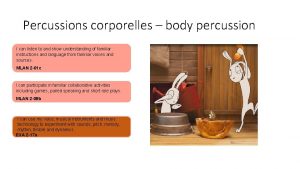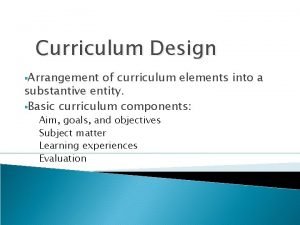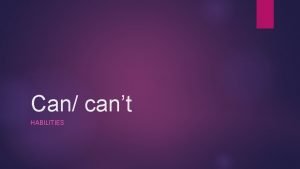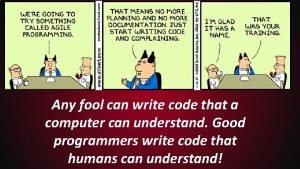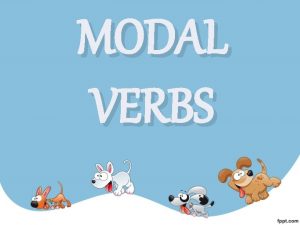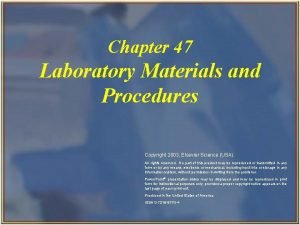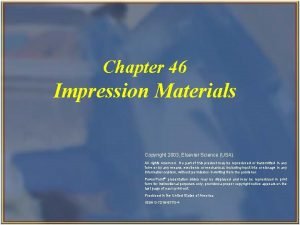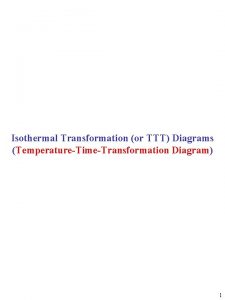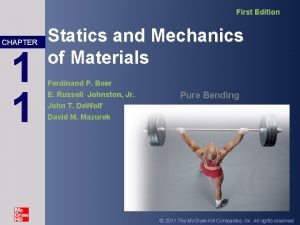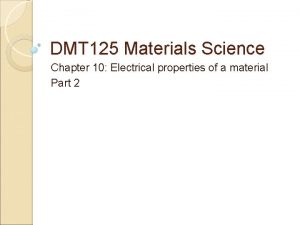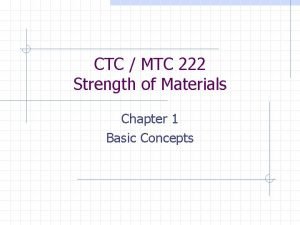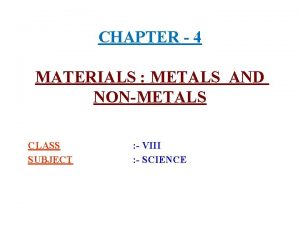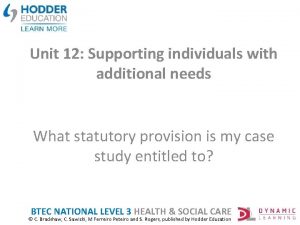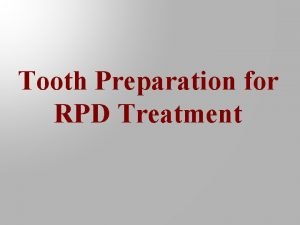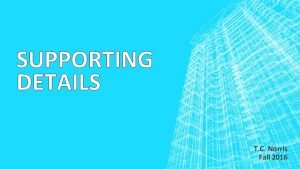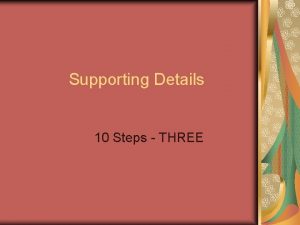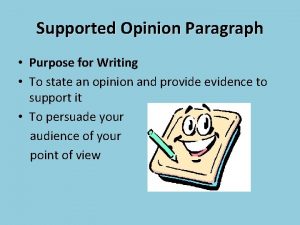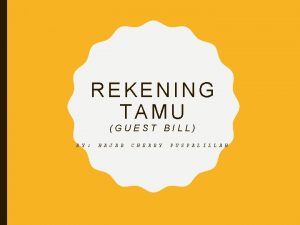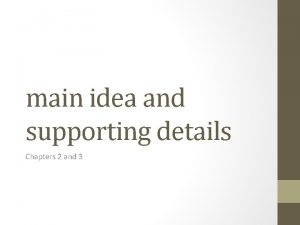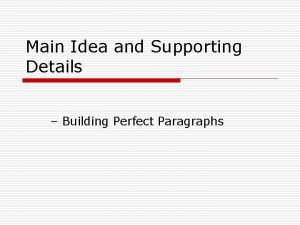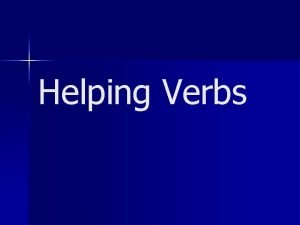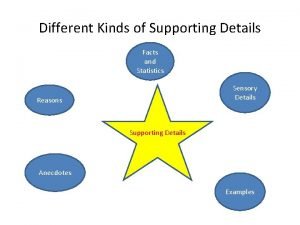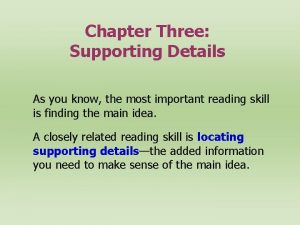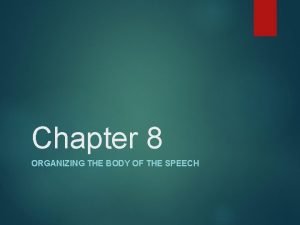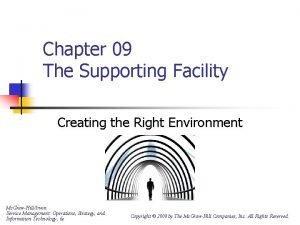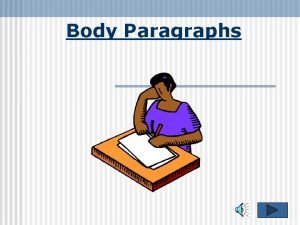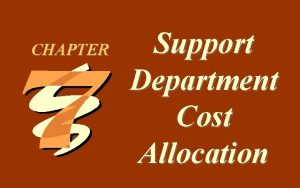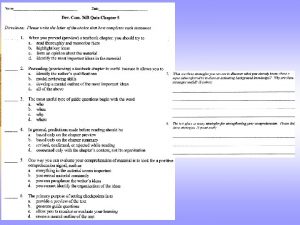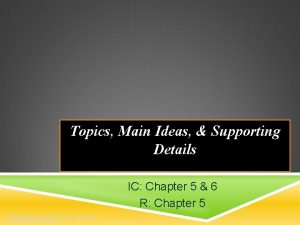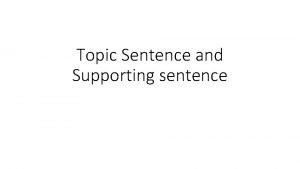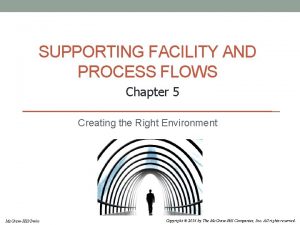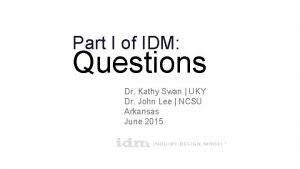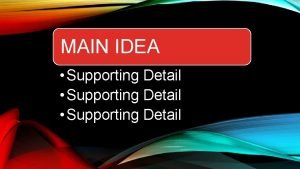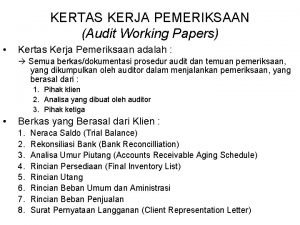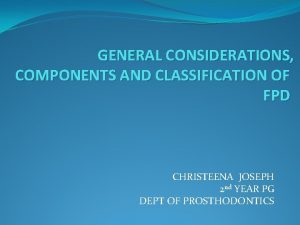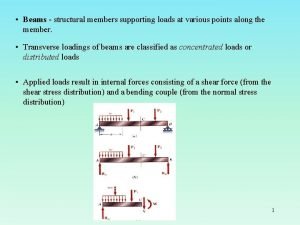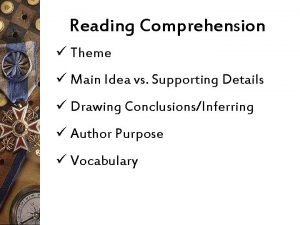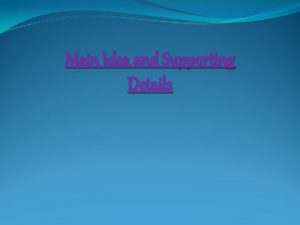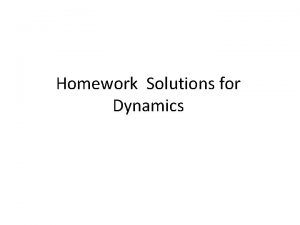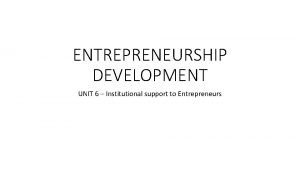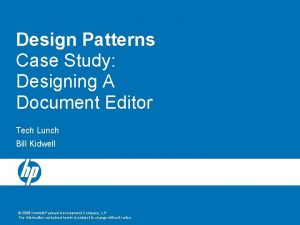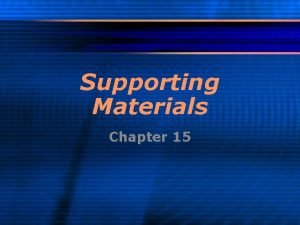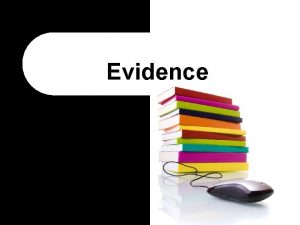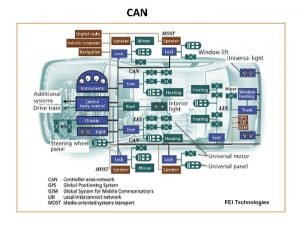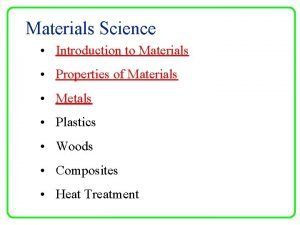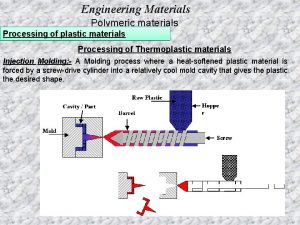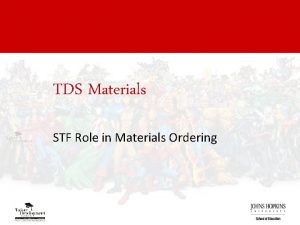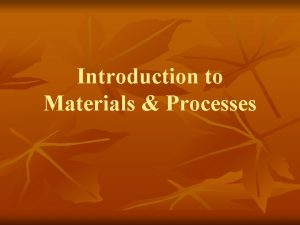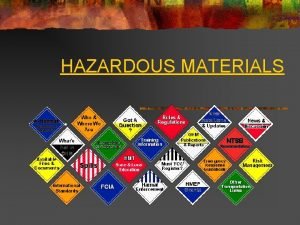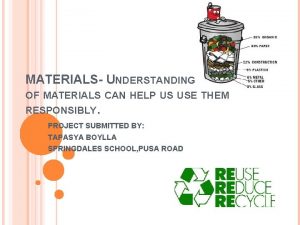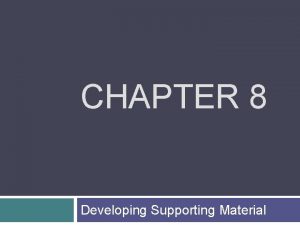Supporting Materials Chapter 15 Supporting Materials l Can














































































































- Slides: 110

Supporting Materials Chapter 15

Supporting Materials l Can be used for clarification or proof l Can be used to support your claims l Can be used as amplification Sprague Chapter 15 2

Define Unfamiliar Words And Concepts l Logical definitions -dictionary definitions l Etymological definitions - root meaning of the word Sprague Chapter 15 3

Definitions l Historical definitions – linked to some historical event l Operational definitions – tell how the object works Sprague Chapter 15 4

Definitions l Definition by negation – explain what the word is not l Authority – person with most credibility gets to define the term l Example – by pointing at it verbally or literally Sprague Chapter 15 5

Make Frequent Use of Examples l Use factual examples n Are sufficient examples given? n Are the examples representative? n Are negative instances accounted for? Sprague Chapter 15 6

Make Frequent Use of Examples l Use hypothetical examples – not factual but it should be a likely or realistic example n Extended n Brief Sprague Chapter 15 7

Examples l Make sure your examples are not biased l Use the appropriate amount of detail n Analyze need Sprague the amount of detail you Chapter 15 8

Use Statistical Evidence l Test the accuracy of statistical evidence n Who collected the data? n Why were the data collected? n When were the data collected? n How were the data collected? Sprague Chapter 15 9

Statistical Evidence l Avoid misleading statistics n The fallacy of average n The fallacy of the unknown base n The fallacy of the atypical or arbitrary time frame l Make your statistics clear and meaningful Sprague Chapter 15 10

Draw on Testimonies from Authorities l Testimonies call on statements from other people to get our point across n Direct quotation n Paraphrase Sprague Chapter 15 11

Evaluate the Credibility of the Authorities You Cite l Does the authority have access to the necessary information? l Is the authority qualified to interpret data? Sprague Chapter 15 12

Evaluate the Credibility of the Authorities You Cite l Is the person acknowledged as an expert on this subject? l Is the authority figure free of bias and self-interest? l Do not distort quotations Sprague Chapter 15 13

Cite Your Sources Smoothly l Cite the sources of your supporting materials l Use a variety of lead-ins Sprague Chapter 15 14

Sample questions. . .

Definitions, examples, statistics and testimony all fall into what the text calls ----- for your speech. Supporting materials

Which should come first: --selecting evidence / supporting materials -- practicing delivery --setting up the basic structure of your speech --doing an audience analysis --setting up the basic structure of your speech

We refer to supporting materials as --, even though it may be impossible to ever prove a point completely. proof

In helping the audience understand our terms and ideas, a(n) ---- definition is also known as dictionary definition. logical

Reasoning Chapter 16

What is Reasoning? Reasoning is the process by which we come to understand something new, through analyzing and synthesizing what we already know. Sprague Chapter 16 21

What is Reasoning? ** This concept is the foundation for thoroughly developing a thesis. . . and for an audience’s critical evaluation of the content used to support your thesis. ** Sprague Chapter 16 22

Identify Where Reasoning is Needed to Link Points l Evidence can lead to more than one claim l People look for familiar patterns Sprague Chapter 16 23

Inductive Reasoning Collecting enough instances to establish a pattern or drawing inferences/conclusions from observations. Sprague Chapter 16 24

Inductive Reasoning l Base inferences on sufficient and representative cases l Recognize the degree of probability of your claim l Demonstrate your cost-rewards analysis Sprague Chapter 16 25

Deductive Reasoning Making verbal statements, or premises, according to formal rules or reasoning from generalizations to specific conclusions. Sprague Chapter 16 26

Deductive Reasoning l Finds the patterns in what you already know l In a formal deductive syllogism, the major premise sets up an absolute relationship Sprague Chapter 16 27

Deductive Reasoning l Probable premises can lead only to probable conclusions l Lay out all the premises of a deductive argument Sprague Chapter 16 28

Causal Reasoning Is the backbone of all speeches that deal with policy and problem solving and is reasoning that one cause invariably leads to one effect Sprague Chapter 16 29

Causal Reasoning l Test the validity of your causal relationships n Do the alleged cause and alleged effect occur together? n Do the alleged cause and alleged effect vary together? Sprague Chapter 16 30

Causal Reasoning l Do not simplify the relationship n Some effects have multiple causes n Some cause are also effects l Explain your causal claims fully and fairly Sprague Chapter 16 31

Reasoning by Analogy When we reason by analogy, we compare two things that can be placed in the same category Sprague Chapter 16 32

Reasoning by Analogy l Compares two things in the same category l Be sure that the two cases are similar Sprague Chapter 16 33

Reasoning by Analogy l Do not confuse a literal analogy with a figurative analogy n Literal analogy compares the members of the same category n Figurative analogy compares the members of different categories Sprague Chapter 16 34

Avoid Common Reasoning Fallacies l Ad hominem – attacking the person instead of the argument l “Setting up a straw figure” – setting up a poor argument, attributing it to the other side, and refuting it. Sprague Chapter 16 35

Avoid Common Reasoning Fallacies l Extending an argument to absurd lengths – goes beyond a reasonable interpretation of the original point Sprague Chapter 16 36

Avoid Common Reasoning Fallacies l Slippery slope - false assumptions that if one takes a particular first step then they will automatically take other dangerous steps in the same direction. Sprague Chapter 16 37

Avoid Common Reasoning Fallacies l Circular reasoning - assumes as one of its premises the very conclusion it sets out to establish l Semantic fallacy – when meanings of word shift mid argument Sprague Chapter 16 38

Avoid Common Reasoning Fallacies l False dichotomy – is reasoning based on an either-or statement when the two alternatives are not mutually exclusive Sprague Chapter 16 39

Avoid Common Reasoning Fallacies l Faulty reversal of an if-then statement - affirming the consequent or denying the antecedent Sprague Chapter 16 40

Avoid Common Reasoning Fallacies l Hasty generalization - making a premature general conclusion l Confusing sequence with cause n Post Sprague hoc fallacy Chapter 16 41

Show How Your Reasoning Links Your Evidence to Your Claim l Organize points to show the logical relationship l Select language that shows the logical relationship Sprague Chapter 16 42

When we reason by -------, we compare two things that can be placed in the same category. analogy

Of the four patterns of reasoning, ------ is the simplest and most common, and consists of collecting enough instances to establish a pattern. Inductive reasoning

Among the various ‘reasoning fallacies, ’ ----- is attacking the person instead of the argument Ad hominem

Language and Style Chapter 17

Strive for Clear Language l Once we have realistic content that is well organized and well supported through good evidence. . . l A good speech pulls the ideas togther through a performance Sprague Chapter 17 47

Think back. . . l Three communication resources. . . l Draw on your conversation skills n Relaxed, l Draw spontaneous, etc. on your writing skills n Research l Draw on your performance skills n Timing, Sprague and evidence emotional build-up, eye contact Chapter 17 48

Strive for Clear Language l Be precise n Use the proper word n Don’t misuse your metaphor Sprague Chapter 17 49

Strive for Clear Language l Use specific and concrete language l Be economical in your language Sprague Chapter 17 50

Use Appropriate Language l Adapt your language to the formality of the occasion l Use jargon or slang carefully l Avoid substandard usage l Use language that is respectful and inclusive l Remember ‘dialect’ impact Sprague Chapter 17 51

Use Valid Varied Language l Use imagery l Use stylistic devices n Simile and metaphor n Personification n Hyperbole Sprague Chapter 17 52

Use Valid Varied Language l Use stylistic devices n Repetitive language or structure n Alliteration and assonance n antithesis Sprague Chapter 17 53

Use Valid Varied Language l Use fresh language l Vary the rhythm of your sentences Sprague Chapter 17 54

------- is a special vocabulary used primarily within a particular group. jargon

Definitions, examples, statistics and testimony all fall into what the text calls ----- for your speech. Supporting materials

Definitions, examples, statistics and testimony all fall into what the text calls ----- for your speech. Supporting materials

Vocal Delivery Chapter 25

Speak to be Heard and Understood l Speak loud enough to be heard by the entire audience -projection l Speak at a rate your audience can follow Sprague Chapter 25 59

Speak to be Heard and Understood l Enunciate words distinctly and naturally l If you have an accent or dialect issues, consider adjustments Sprague Chapter 25 60

Use Vocal Variety l Vary your pitch l Vary your rate of speech l Vary your volume l Avoiding ‘monotone’ or ‘constant vocal pattern’ Sprague Chapter 25 61

Use Standard, Acceptable Pronunciation l Identify words that you habitually mispronounce l Check the preferred pronunciation of unfamiliar words l Recall: common words, names of places Sprague Chapter 25 62

Eliminate Distracting Vocal Characteristics l Identify problems of voice quality n Harshness n Breathiness n Nasality l Identify and denasality problems of articulation n Vocalized pauses (um, so, you know) n Repetitious patterns of inflection Sprague Chapter 25 63

Physical Delivery Chapter 26

Physical Delivery l Be conscious of your appearance n Manage your first impression n Dress conservatively n Dress up / no cap / jewelry? l Eliminate distracting mannerisms l Stand or sit with a relaxed but alert posture Sprague Chapter 26 65

Physical Delivery l Make only purposeful and relevant movements l Make natural gestures l Maintain eye contact l Use facial expressions to reflect tone Sprague Chapter 26 66

Attention & Interest Chapter 18

Use Appropriate Attention. Getting Techniques l Activity or movement— appropriate movement of the speaker and a lively treatment of the content that creates a feeling of something happening l Reality—references to actual people, events, and places; being specific and concrete rather than abstract Sprague Chapter 18 68

Use Appropriate Attention. Getting Techniques l Proximity—references to what is close at hand: people in the room, current events, local landmarks, and so on l Familiarity—the use of recognized examples, wellknown phrases, and commonplace situations Sprague Chapter 18 69

Use Appropriate Attention. Getting Techniques l Novelty—the opposite of the familiar: startling facts, odd turns of phrase, surprising images, and unusual combinations l Suspense—stimulation of curiosity about what will happen next through puzzles or provocative questions Sprague Chapter 18 70

Use Appropriate Attention. Getting Techniques l Conflict—pros and cons, opposing viewpoints, competing schools of thought l Humor—playful remarks, silly or exaggerated images, amusing plays on words, ironic twists of fate, entertaining stories, and the like Sprague Chapter 18 71

Use Appropriate Attention. Getting Techniques l The vital—references to things that are important to listeners, ranging from matters of survival to anything that saves them time, earns them money, or makes their life more pleasant Sprague Chapter 18 72

Use Techniques that Enliven Your Speech l Be specific and use real life examples l Keep your audience involved l Use the names of people in your audience l Refer to details in the immediate setting or from common experiences Sprague Chapter 18 73

Use Techniques that Enliven Your Speech l Actively involve your audience l Use variety and movement to energize your speech l Use humor when it is appropriate Sprague Chapter 18 74

Use Techniques that Enliven Your Speech l Look for the humor in your everyday experience l Be selective when you draw on collected humor Sprague Chapter 18 75

Convert Attention to Interest l Link your topic to your listeners’ self-interest l Incorporate storytelling techniques Sprague Chapter 18 76

Avoid Common Attention Pitfalls l Avoid questionable attention grabbers l Don’t let a story or joke take over your speech l Don’t tell jokes unless you can tell them well l Don’t let audience participation cause you to lose control Sprague Chapter 18 77

Definitions, examples, statistics and testimony all fall into what the text calls ----- for your speech. Supporting materials

Definitions, examples, statistics and testimony all fall into what the text calls ----- for your speech. Supporting materials

Credibility Chapter 19

Assess Your Speaking Image l Are you perceived as n Competent? n Concerned welfare? l Are about your audiences you perceived as n Trustworthy? n Dynamic? Sprague Chapter 19 81

Build Your Credibility Before Your Speech l Provide the contact person with information about your qualifications l Help the person introducing you set a favorable tone l Manage your image during contact with the group before the speech Sprague Chapter 19 82

Build Your Credibility Through Your Content l Present your credentials l Demonstrate a thorough understanding of your topic Sprague Chapter 19 83

Build Your Credibility Through Your Content l Be sure your material is clearly organized l Present a balanced and objective analysis l Express your concern for the audience Sprague Chapter 19 84

Motivational Appeals Chapter 20

Consider the Emotional Impact You Want to Create or Avoid l Devoid of emotion l Moderate emotion l Excessive emotion Sprague Chapter 20 86

Relate Your Speech to the Needs of Your Listeners l Maslow’s hierarchy of needs n Physiological needs n Safety needs n Love and belongingness needs n Self-esteem needs n Self-actualization Sprague Chapter 20 87

Relate Your Speech to the Needs of Your Listeners l Maslow’s hierarchy of needs n Physiological needs n Safety needs n Love and belongingness needs n Self-esteem needs n Self-actualization Sprague Chapter 20 88

Rational vs. emotional appeals l Buying a car? l Gas saving, low cost, safety l Color, style, status Sprague Chapter 20 89

Relate Your Speech to the Values of Your Listeners l Link the issues of your speech to the value of your audience l Appeal to your listener’s sense of community l Avoid excessive and inappropriate motivational appeals Sprague Chapter 20 90

Informative Strategies Chapter 21

Help Your Listeners Grasp Your Information l Avoid information overload l Give listeners a framework for organizing the information l Select and implement a specific organizational pattern: Topical, spatial, chronological, causal Sprague Chapter 21 92

Major Content Types of Informative Speeches l Speeches about Sprague objects / items processes events concepts Chapter 21 93

Help Your Listeners Grasp Your Information l Move from the simple to the complex l Move from the familiar to the unfamiliar Sprague Chapter 21 94

Use Common Techniques of Clear Explanation l Use organizers n Sign posts n Emphasis cues l Use Sprague examples liberally Chapter 21 95

Use Common Techniques of Clear Explanation l Use analogies l Use multiple channels and modes l Use repetition and redundancy Sprague Chapter 21 96

Presentation Aids Chapter 27

Plan How to Use Presentation Aids l Decide if a visual aid is appropriate l Use when there is a benefit l Determine the form and technology for your purpose l Present info conversationally Sprague Chapter 27 98

Plan How to Use Presentation Aids l Decide the best way to represent an object or concept visually n Graph/picture n Line graph n Pie graph n Flowchart n Table or grid Sprague Chapter 27 99



Wi-Fi Radio Plans l Home wi-fi radio

Making Money: The Sound. Exchange Problem l NAB - Sound. Exchange Settlement l 2006 - $. 0008 2007 - $. 0011 2008 - $. 0014 2009 - $. 0015 2010 - $. 0016 2011 - $. 0017 2012 - $. 0020 2013 - $. 0022 2014 - $. 0023 2015 - $. 0025 l l l l l

Prepare Your Aids to be Clear and Manageable l Make sure the entire audience can see (and hear) your aid l Keep it simple and clear l Design for maximum audience impact Sprague Chapter 27 104

Blend Your Aids Smoothly into the Speech l Practice with your aids l Have your aid ready to go l Maintain eye contact with your audience Sprague Chapter 27 105

Blend Your Aids Smoothly into the Speech l Keep talking while using your aid l Balance them throughout the speech l Don’t let it become a distraction l Don’t spend too much time on it l Keep eye contact with audience Sprague Chapter 27 106

Use Presentation Software Wisely l Keep your text slides simple l Maintain consistency l Use clip art sparingly l Technique for showing at appropriate time l Give source credit (you are plagiarizing if you use a visual created by someone else) Sprague Chapter 27 107

Impromptu Speeches l If Sprague time. . . Chapter 27 108

Critique Speeches l Speaker 1 l Speaker 2

 Natural materials
Natural materials Examples of useful and harmful materials at home
Examples of useful and harmful materials at home Man made materials
Man made materials Differentiate adopting materials and adapting materials
Differentiate adopting materials and adapting materials Direct materials budget with multiple materials
Direct materials budget with multiple materials Materials that blocks light
Materials that blocks light If you can imagine it you can achieve it
If you can imagine it you can achieve it Kinds of comparison
Kinds of comparison If you think you can you can poem
If you think you can you can poem If you can't measure it, you can't manage it
If you can't measure it, you can't manage it If you can’t measure it, you can’t manage it
If you can’t measure it, you can’t manage it Can can body percussion
Can can body percussion The arrangement of the elements of curriculum is called
The arrangement of the elements of curriculum is called You can tell harris about it just ____(easily) as i can
You can tell harris about it just ____(easily) as i can Positive comparative superlative
Positive comparative superlative I can could speak english but i can't write it very well
I can could speak english but i can't write it very well Look at the pictures and complete with can or can't
Look at the pictures and complete with can or can't The cool bear hunt dr jean
The cool bear hunt dr jean Through you i can do anything
Through you i can do anything If you cannot measure it you cannot manage it
If you cannot measure it you cannot manage it Talk en futuro
Talk en futuro Any fool can write code that a computer can understand
Any fool can write code that a computer can understand Poetic devices in sonnet 18
Poetic devices in sonnet 18 Goldene bilanzregel
Goldene bilanzregel Modal verbs inability
Modal verbs inability Beer johnston
Beer johnston Mechanics of materials chapter 9
Mechanics of materials chapter 9 Mechanics of materials 6th edition solutions chapter 7
Mechanics of materials 6th edition solutions chapter 7 Mechanics
Mechanics Mechanics of materials 6th edition solutions chapter 5
Mechanics of materials 6th edition solutions chapter 5 Mechanics of materials chapter 4
Mechanics of materials chapter 4 Mechanics of materials chapter 3
Mechanics of materials chapter 3 Beer and johnson
Beer and johnson Chapter 47 laboratory materials and procedures
Chapter 47 laboratory materials and procedures What are the three curing stages of impression materials?
What are the three curing stages of impression materials? Introduction to materials science for engineers chapter 10
Introduction to materials science for engineers chapter 10 Beer johnston
Beer johnston Mechanics of materials chapter 3 solutions
Mechanics of materials chapter 3 solutions Mechanics of materials chapter 3 solutions
Mechanics of materials chapter 3 solutions Mechanics
Mechanics Introduction to materials science for engineers chapter 10
Introduction to materials science for engineers chapter 10 Strength of materials chapter 1
Strength of materials chapter 1 Chapter 4 metals and nonmetals
Chapter 4 metals and nonmetals Mechanics
Mechanics Composition of dental stone
Composition of dental stone What is the name of the quantity represented as i^?
What is the name of the quantity represented as i^? Closing sentence examples
Closing sentence examples Hollow ground chamfer
Hollow ground chamfer Unit 12 additional needs
Unit 12 additional needs Rpd rest preparation
Rpd rest preparation Evidence supporting efficient market hypothesis
Evidence supporting efficient market hypothesis Axial fixation suspension
Axial fixation suspension Quotations of paraphrases used to support a point.
Quotations of paraphrases used to support a point. Supporting material examples
Supporting material examples Supporting details examples
Supporting details examples Example of main idea and supporting details
Example of main idea and supporting details An opinion paragraph example
An opinion paragraph example Fungsi guest bill
Fungsi guest bill Compelling vs supporting questions
Compelling vs supporting questions Forebite
Forebite Principles of information security 5th edition pdf
Principles of information security 5th edition pdf Tula about helping others
Tula about helping others Contoh controlling idea
Contoh controlling idea Major details vs minor details
Major details vs minor details What is major details
What is major details Tell more about the main idea
Tell more about the main idea Outline main idea and supporting details
Outline main idea and supporting details Main idea and supporting details examples
Main idea and supporting details examples Main idea and details jeopardy
Main idea and details jeopardy Helping verbs
Helping verbs Example of irrelevant
Example of irrelevant Fixation omission emphasis
Fixation omission emphasis Opinions are better than facts in supporting an argument.
Opinions are better than facts in supporting an argument. Supporting details types
Supporting details types Contoh supporting service
Contoh supporting service Supporting tissue
Supporting tissue Main idea and supporting details examples
Main idea and supporting details examples Supporting points
Supporting points Signpost in speech
Signpost in speech Supporting facilities
Supporting facilities What is topic sentence example
What is topic sentence example Retromylohyoid fossa classification
Retromylohyoid fossa classification Instrument cross check
Instrument cross check Muscle tissue where is it found
Muscle tissue where is it found Fovae palatine
Fovae palatine Secondary stress bearing area definition
Secondary stress bearing area definition Supporting department adalah
Supporting department adalah Minor support sentence
Minor support sentence Compelling question definition
Compelling question definition Main idea and supporting details definition
Main idea and supporting details definition What is supporting sentence
What is supporting sentence Supporting facility example
Supporting facility example Supporting facilities example
Supporting facilities example Supporting documents for job application
Supporting documents for job application Topic sentence supporting details
Topic sentence supporting details Lesson 5 staff and support agencies
Lesson 5 staff and support agencies Compelling and supporting questions examples
Compelling and supporting questions examples Supporting detail
Supporting detail Whats supporting details
Whats supporting details Did the supporting details support the main idea how
Did the supporting details support the main idea how Contoh top schedule dan supporting schedule
Contoh top schedule dan supporting schedule Classification of fpd
Classification of fpd Supporting sentence 例
Supporting sentence 例 The structural members supporting loads at various points.
The structural members supporting loads at various points. Characteristics of services
Characteristics of services Theme vs topic
Theme vs topic Main idea and supporting details
Main idea and supporting details Statistic hook
Statistic hook Homework
Homework Sisi in entrepreneurship
Sisi in entrepreneurship Designing a document editor in design patterns
Designing a document editor in design patterns











